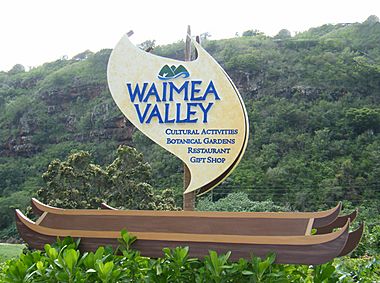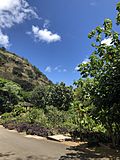Waimea Valley facts for kids
Waimea Valley is an area of historic cultural significance on the North Shore of Oahu, Hawaii. The valley, being an important place in Hawaiian religion, includes several historical structures including stone terraces and walls constructed during the time of the Hawaiian monarchy. The nutrient-rich volcanic soil combined with a rainy environment provided the resourceful Hawaiians of the area the opportunity to create one of the most prosperous farming communities in all of Polynesia. The area had complex fish ponds, domesticated animal pens, various large farming beds, and was famous for the cultivation of pink taro root stock, a coveted item to the Ali`i (the Hawaiian elite). Much of the garden floor was once cultivated for taro, sweet potato, and bananas, with new crops and orchards introduced by Europeans after their arrival.
Contents
Sacred Hawaiian mythology
Waimea Valley was considered one of the more recognized locations for its spiritual significance. Ancient Hawaiians were thought to partake in various indigenous religious activities, like human sacrifice. O’ahu’s largest heiau, or temple, resides there, overlooking the valley.
Ancient ownership of Waimea Valley
In 1092 Waimea Valley was given to the high priests or the Kahuna Nui. It eventually became the home of one of the most distinguished priesthoods in the islands, the Pa'ao. Kamehameha the Great's exclusive Kahuna, Hewahewa, was a descendant of the Pa'ao. The Kahuna Nui were essential to Hawaiian society because they were the experts in various fields like farming, healing, spiritual guidance, fishing, and teaching both the Ali’i and the common people. Over the course of time, Waimea became known as “the valley of the priests”.
After O`ahu was conquered by Kamehameha, he then gave ownership of Waimea Valley to Hewa Hewa Nui, to maintain the sacred importance of the area.
Western contact
The first Europeans to touch the island of O’ahu were the crews of the Resolution and the Discovery shortly after the death of Captain Cook in 1779.
Historical nature park
Formerly known as the Waimea Valley Audubon Center and the Waimea Arboretum and Botanical Garden, the Waimea Valley is a historical nature park including botanical gardens. It is located at 59-864 Kamehameha Highway, Haleiwa, Oahu, Hawaii and is open daily except for Christmas and New Year's Day; an admission fee is charged.
The garden was managed until 2003 by the City and County of Honolulu, when management was assumed by the National Audubon Society. In 2008, management was handed over to Hi'ipaka LLC, a non-profit company created by the Office of Hawaiian Affairs.
The garden now contains 35 distinct collections, representing some 5,000 taxa from around the world. It contains one of the finest collections of Polynesian plants in existence, as well as excellent collections of very rare Hawaiian plants, rare and endangered species native to Lord Howe Island, and individual gardens dedicated to plants from Guam, Madagascar, the Mascarene Islands, the Ogasawara Islands, and the Seychelles.
Other major collections include the hibiscus evolutionary garden, araceae, bauhinia, bromeliaceae, heliconia, liliaceae, as well as bamboo, begonia, ferns, tropical fruit, etc. Among many other tropical plants of note, there are Calamondin citrus trees in the parking lot.
The garden valley is approximate 0.75 miles (1.21 km) in length, with a small waterfall and swimming hole at the valley's hind end.
=Images for kids
Activities
The falls have been used for cliff diving featuring hourly exhibition. Swimming is allowed when divers are not performing and when the weather permits. Additionally, hula performances were done several times daily.
See also
 In Spanish: Valle Waimea para niños
In Spanish: Valle Waimea para niños






